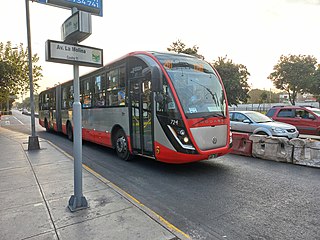
The Lima and Callao Metro is a rapid transit system that serves the cities of Lima and Callao, which make up the Lima metropolitan area. The existing metro lines currently link the district of Villa El Salvador in the south of Lima with San Juan de Lurigancho in the northeast of the city, as well as a 5 km (3.1 mi) segment in the east of the metro area. Furthermore, there are four additional lines planned for the network.

The Lima Metropolitan Area is an area formed by the conurbation of the Peruvian provinces of Lima and Callao. It is the largest of the metropolitan areas of Peru, the seventh largest in the Americas, the fourth largest in Latin America, and among the thirty largest in the world. The conurbation process started to be evident in the 1980s.

Surquillo is a district located in Lima, Peru. The district is bordered by the districts of San Isidro and San Borja on the north; by Miraflores on the south and west; and by Santiago de Surco on the east.

The Historic Centre of Lima is the historic city centre of the city of Lima, the capital of Peru. Located in the city's districts of Lima and Rímac, both in the Rímac Valley, it consists of two areas: the first is the Monumental Zone established by the Peruvian government in 1972, and the second one—contained within the first one—is the World Heritage Site established by UNESCO in 1988, whose buildings are marked with the organisation's black-and-white shield.

The Metropolitan Municipality of Lima is the local government entity of the Lima Province and Lima District. It is the only provincial municipality of special regime with faculties of regional government. It is established according to the 2002 Organic Law of Regional Governments and the 2003 Organic Law of Municipalities.

María Eloisa Meléndez Altieri also known as Mayita, is a Puerto Rican politician who served as the mayor of the city of Ponce, Puerto Rico, from 2009 to 2021. Meléndez Altieri was elected during the Puerto Rican general elections of 2008, becoming the first woman elected to the office in Ponce's political history. She was also the first mayor of a party other than the Popular Democratic Party in Ponce since 1989, when Rafael Cordero Santiago became mayor. This is Mayita's second candidacy in politics on the island and her first electoral win. In the Puerto Rico's 2004 general election, Mayita presented her candidacy for a senatorial seat representing Puerto Rico's 5th district, but lost in her bid for the position. Meléndez Altieri lost her bid for reelection in the 2020 general elections to Luis Irizarry Pabon from the Popular Democratic Party.

Alejandro Octavio Deustua Escarza was a Peruvian philosopher, educator and statesman. He was the Prime Minister of Peru from 9 August 1902 until 4 November 1902.

Transmetro, officially, Sistema Integrado de Transporte Masivo de Barranquilla y su Área Metropolitana, is a mass transit system that has operated in the city of Barranquilla, Colombia since April 7, 2010.

Metropolitano is a bus rapid transit system serving the city of Lima, Peru. Its construction began in the year 2006.
Public transport in Lima consists of buses, minibuses, taxis, and mototaxis. Micros are the most common means of public transportation in Lima and many other cities in Peru. There are also more than 100 kilometres (62 mi) of cycle paths in the city.

Guarulhos–São Paulo Metropolitan Corridor is a 12.3 km (7.6 mi) long bus corridor, with 3 bus terminals and 19 bus stops. When concluded, it will be 20 km (12 mi) long, with 5 bus terminals, and will attend approximately 100,000 daily passengers.
The Flora Tristán Peruvian Women's Center is a feminist non-governmental organization established in Lima in 1979 in defense of women's human rights and equality.

The Red de Transporte de Pasajeros de la Ciudad de México offers urban bus service in Mexico City. It is administered by the Government of Mexico City and carries approximately 400,000 passengers per day on more than 100 routes.

The National Urban Transport Company of Peru, better known by its initials, ENATRU, was a state company in charge of urban transport in different departments of Peru established under the country's left-wing military government. It existed between 1975 and 1992.

The Lima Tramway was a mass transportation system that serviced the city of Lima, as well as then neighbouring Callao, Magdalena del Mar, Miraflores, Barranco and Chorrillos, inaugurated in 1878 and closed in 1965.

The Urban Transport Authority for Lima and Callao is a specialised technical organisation of the Ministry of Transportation and Communications. Its main function is to integrate and articulate urban public transportation in the Lima metropolitan area.

The complementary corridors are a bus transit system that serves the metropolitan area of Lima and Callao. It is a network of bus systems that cover the main avenues of the metropolitan area.















